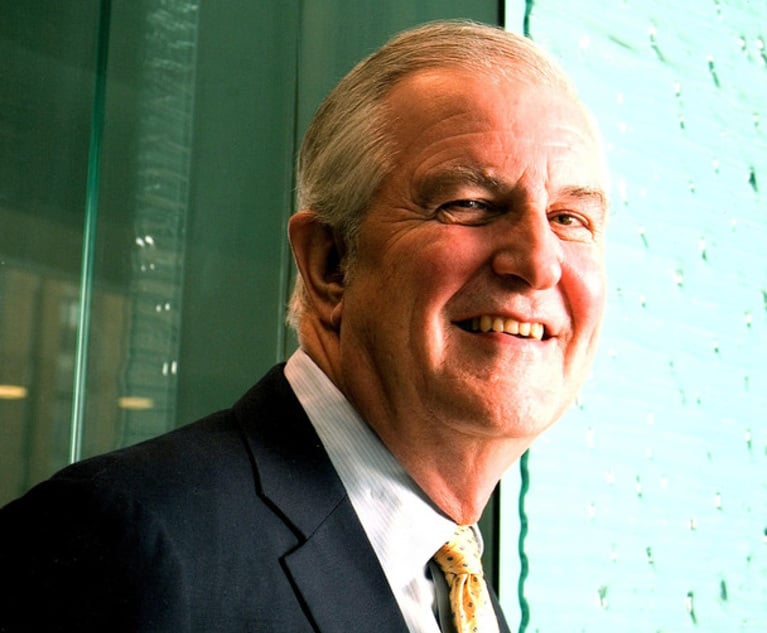 Wilmer Cutler Pickering Hale and Dorr partner Seth Waxman
Wilmer Cutler Pickering Hale and Dorr partner Seth WaxmanFederal Circuit Asked to Dial Back $254 Million Award
District judges need guidance on applying the Supreme Court's new willfulness framework, Wilmer's Seth Waxman argues for Zimmer Inc.
December 05, 2018 at 08:08 PM
3 minute read
It's been two and a half years since Stryker Corp. and Zimmer Inc. took their long-running patent infringement dispute to the U.S. Supreme Court, ending in a new, more relaxed standard for imposing enhanced damages on willful infringement.
But the two medical device companies are still thrashing out exactly how much money Zimmer should pay for willfully infringing Stryker's patents on specialty suction devices. On remand from the Supreme Court, U.S. District Chief Judge Robert Jonker of the Western District of Michigan again imposed the maximum penalty, trebling the jury's $70 million award. With supplemental damages, prejudgment interest and an $8 million attorney fee award, the total came to $254 million.
On Monday, Wilmer Cutler Pickering Hale & Dorr partner Seth Waxman argued to the U.S. Court of Appeals for the Federal Circuit that Zimmer shouldn't have to swallow one of the largest enhanced damage awards in patent history. He accused Jonker of mechanically applying the Read factors—a set of guidelines district judges use when considering enhancements—in a mechanical, check-the-box fashion. What's more, Jonker ignored that the Federal Circuit itself has found in previous appeals that Zimmer's trial defenses were “not unreasonable.”
“The district court's award of the maximum enhanced damages was flawed as a matter of law,” Waxman said in Stryker v. Zimmer, asking the judges to “clarify and correct the district court's confusion on the meaning of the Read factors, in order to provide lower courts with guidance.”
While one of the judges suggested that some clarification could be in order, it didn't sound as if it would help Waxman's client.
“You're agreeing there's going to be enhancement, and now we're talking about whether the enhancement ought to be three times or two and a half times or one and one quarter times,” Chief Judge Sharon Prost said. While “maybe, maybe not” the appellate judges might agree it should be somewhat less, it's not the appellate court's role to scrutinize the percentage. “Your argument is they went too far, but how far is too far?” she said.
Waxman argued that the Supreme Court made clear that treble damages are reserved for “the worst of the worst” and that there are numerous mitigating factors on Zimmer's side, including that Stryker waited 10 years to bring its infringement suit.
Stryker's attorney, Sharon Hwang of McAndrews, Held & Malloy, argued that the Supreme Court adopted a flexible “totality of the circumstances” test for willfulness, and that Jonker did not abuse his discretion in applying it.
Judges Kathleen O'Malley and Todd Hughes expressed concern about Jonker's use of the Read factors. “Do you agree that district courts are sort of all over the board in how they apply the Read factors and there needs to be some guidance,” O'Malley asked, “regardless of how we come out?”
“I think if we've learned anything” from the Supreme Court's decision, “it's that there's no rigid formula here,” Hwang said. “These are all very fact-specific circumstances.”
This content has been archived. It is available through our partners, LexisNexis® and Bloomberg Law.
To view this content, please continue to their sites.
Not a Lexis Subscriber?
Subscribe Now
Not a Bloomberg Law Subscriber?
Subscribe Now
NOT FOR REPRINT
© 2025 ALM Global, LLC, All Rights Reserved. Request academic re-use from www.copyright.com. All other uses, submit a request to [email protected]. For more information visit Asset & Logo Licensing.
You Might Like
View All

‘Not a Regulatory Gray Area’: CFTC Secures $5M Settlement From Gemini
3 minute read

Corporate Disclosure Law Enjoys ‘Presumption of Constitutionality,’ Feds Tell Justices
Trending Stories
- 1Attorneys, Health Care Officials Face Nearly $80M RICO Suit Over Allegedly Fabricated Spreadsheet
- 2Financially Grounded: South Florida-Based Silver Airways Files for Bankruptcy
- 3Cozen O'Connor Accused of Overbilling, Duplicate Work
- 4Texas Judge Resigns Amid Ethics Case
- 5Skadden Corporate Partner Departs For Cooley in Beijing
Who Got The Work
Michael G. Bongiorno, Andrew Scott Dulberg and Elizabeth E. Driscoll from Wilmer Cutler Pickering Hale and Dorr have stepped in to represent Symbotic Inc., an A.I.-enabled technology platform that focuses on increasing supply chain efficiency, and other defendants in a pending shareholder derivative lawsuit. The case, filed Oct. 2 in Massachusetts District Court by the Brown Law Firm on behalf of Stephen Austen, accuses certain officers and directors of misleading investors in regard to Symbotic's potential for margin growth by failing to disclose that the company was not equipped to timely deploy its systems or manage expenses through project delays. The case, assigned to U.S. District Judge Nathaniel M. Gorton, is 1:24-cv-12522, Austen v. Cohen et al.
Who Got The Work
Edmund Polubinski and Marie Killmond of Davis Polk & Wardwell have entered appearances for data platform software development company MongoDB and other defendants in a pending shareholder derivative lawsuit. The action, filed Oct. 7 in New York Southern District Court by the Brown Law Firm, accuses the company's directors and/or officers of falsely expressing confidence in the company’s restructuring of its sales incentive plan and downplaying the severity of decreases in its upfront commitments. The case is 1:24-cv-07594, Roy v. Ittycheria et al.
Who Got The Work
Amy O. Bruchs and Kurt F. Ellison of Michael Best & Friedrich have entered appearances for Epic Systems Corp. in a pending employment discrimination lawsuit. The suit was filed Sept. 7 in Wisconsin Western District Court by Levine Eisberner LLC and Siri & Glimstad on behalf of a project manager who claims that he was wrongfully terminated after applying for a religious exemption to the defendant's COVID-19 vaccine mandate. The case, assigned to U.S. Magistrate Judge Anita Marie Boor, is 3:24-cv-00630, Secker, Nathan v. Epic Systems Corporation.
Who Got The Work
David X. Sullivan, Thomas J. Finn and Gregory A. Hall from McCarter & English have entered appearances for Sunrun Installation Services in a pending civil rights lawsuit. The complaint was filed Sept. 4 in Connecticut District Court by attorney Robert M. Berke on behalf of former employee George Edward Steins, who was arrested and charged with employing an unregistered home improvement salesperson. The complaint alleges that had Sunrun informed the Connecticut Department of Consumer Protection that the plaintiff's employment had ended in 2017 and that he no longer held Sunrun's home improvement contractor license, he would not have been hit with charges, which were dismissed in May 2024. The case, assigned to U.S. District Judge Jeffrey A. Meyer, is 3:24-cv-01423, Steins v. Sunrun, Inc. et al.
Who Got The Work
Greenberg Traurig shareholder Joshua L. Raskin has entered an appearance for boohoo.com UK Ltd. in a pending patent infringement lawsuit. The suit, filed Sept. 3 in Texas Eastern District Court by Rozier Hardt McDonough on behalf of Alto Dynamics, asserts five patents related to an online shopping platform. The case, assigned to U.S. District Judge Rodney Gilstrap, is 2:24-cv-00719, Alto Dynamics, LLC v. boohoo.com UK Limited.
Featured Firms
Law Offices of Gary Martin Hays & Associates, P.C.
(470) 294-1674
Law Offices of Mark E. Salomone
(857) 444-6468
Smith & Hassler
(713) 739-1250










